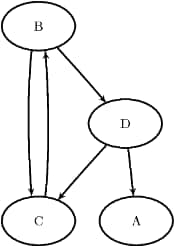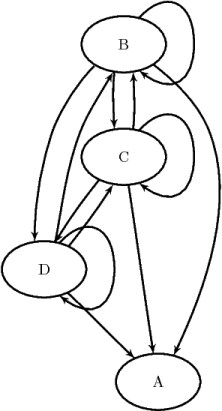The OPTGRAPH Procedure
- Overview
-
Getting Started

-
Syntax
 Functional SummaryPROC OPTGRAPH StatementBICONCOMP StatementCENTRALITY StatementCLIQUE StatementCOMMUNITY StatementCONCOMP StatementCORE StatementCYCLE StatementDATA_LINKS_VAR StatementDATA_MATRIX_VAR StatementDATA_NODES_VAR StatementEIGENVECTOR StatementLINEAR_ASSIGNMENT StatementMINCOSTFLOW StatementMINCUT StatementMINSPANTREE StatementPERFORMANCE StatementREACH StatementSHORTPATH StatementSUMMARY StatementTRANSITIVE_CLOSURE StatementTSP Statement
Functional SummaryPROC OPTGRAPH StatementBICONCOMP StatementCENTRALITY StatementCLIQUE StatementCOMMUNITY StatementCONCOMP StatementCORE StatementCYCLE StatementDATA_LINKS_VAR StatementDATA_MATRIX_VAR StatementDATA_NODES_VAR StatementEIGENVECTOR StatementLINEAR_ASSIGNMENT StatementMINCOSTFLOW StatementMINCUT StatementMINSPANTREE StatementPERFORMANCE StatementREACH StatementSHORTPATH StatementSUMMARY StatementTRANSITIVE_CLOSURE StatementTSP Statement -
Details
 Graph Input DataMatrix Input DataData Input OrderParallel ProcessingNumeric LimitationsSize LimitationsCommon Notation and AssumptionsBiconnected Components and Articulation PointsCentralityCliqueCommunityConnected ComponentsCore DecompositionCycleEigenvector ProblemLinear Assignment (Matching)Minimum-Cost Network FlowMinimum CutMinimum Spanning TreeReach (Ego) NetworkShortest PathSummaryTransitive ClosureTraveling Salesman ProblemMacro VariablesODS Table Names
Graph Input DataMatrix Input DataData Input OrderParallel ProcessingNumeric LimitationsSize LimitationsCommon Notation and AssumptionsBiconnected Components and Articulation PointsCentralityCliqueCommunityConnected ComponentsCore DecompositionCycleEigenvector ProblemLinear Assignment (Matching)Minimum-Cost Network FlowMinimum CutMinimum Spanning TreeReach (Ego) NetworkShortest PathSummaryTransitive ClosureTraveling Salesman ProblemMacro VariablesODS Table Names -
Examples
 Articulation Points in a Terrorist NetworkInfluence Centrality for Project Groups in a Research DepartmentBetweenness and Closeness Centrality for Computer Network TopologyBetweenness and Closeness Centrality for Project Groups in a Research DepartmentEigenvector Centrality for Word Sense DisambiguationCentrality Metrics for Project Groups in a Research DepartmentCommunity Detection on Zachary’s Karate Club DataRecursive Community Detection on Zachary’s Karate Club DataCycle Detection for Kidney Donor ExchangeLinear Assignment Problem for Minimizing Swim TimesLinear Assignment Problem, Sparse Format versus Dense FormatMinimum Spanning Tree for Computer Network TopologyTransitive Closure for Identification of Circular Dependencies in a Bug Tracking SystemReach Networks for Computation of Market Coverage of a Terrorist NetworkTraveling Salesman Tour through US Capital Cities
Articulation Points in a Terrorist NetworkInfluence Centrality for Project Groups in a Research DepartmentBetweenness and Closeness Centrality for Computer Network TopologyBetweenness and Closeness Centrality for Project Groups in a Research DepartmentEigenvector Centrality for Word Sense DisambiguationCentrality Metrics for Project Groups in a Research DepartmentCommunity Detection on Zachary’s Karate Club DataRecursive Community Detection on Zachary’s Karate Club DataCycle Detection for Kidney Donor ExchangeLinear Assignment Problem for Minimizing Swim TimesLinear Assignment Problem, Sparse Format versus Dense FormatMinimum Spanning Tree for Computer Network TopologyTransitive Closure for Identification of Circular Dependencies in a Bug Tracking SystemReach Networks for Computation of Market Coverage of a Terrorist NetworkTraveling Salesman Tour through US Capital Cities - References
Transitive Closure
The transitive closure of a graph G is a graph ![]() such that for all
such that for all ![]() there is a link
there is a link ![]() if and only if there exists a path from i to j in G.
if and only if there exists a path from i to j in G.
The transitive closure of a graph can help to efficiently answer questions about reachability. Suppose you want to answer
the question of whether you can get from node i to node j in the original graph G. Given the transitive closure ![]() of G, you can simply check for the existence of link
of G, you can simply check for the existence of link ![]() to answer the question. Transitive closure has many applications, including speeding up the processing of structured query
languages, which are often used in databases.
to answer the question. Transitive closure has many applications, including speeding up the processing of structured query
languages, which are often used in databases.
In PROC OPTGRAPH, you can invoke the transitive closure algorithm by using the TRANSITIVE_CLOSURE statement. The options for this statement are described in the section TRANSITIVE_CLOSURE Statement.
The results for the transitive closure algorithm are written to the output data set that is specified in the OUT= option in
the TRANSITIVE_CLOSURE statement. The links that define the transitive closure are listed in the output data set with variable
names from and to.
The transitive closure algorithm reports status information in a macro variable called _OPTGRAPH_TRANSCL_. See the section Macro Variable _OPTGRAPH_TRANSCL_ for more information about this macro variable.
The algorithm that the PROC OPTGRAPH uses to compute transitive closure is a sparse version of the Floyd-Warshall algorithm
(Cormen, Leiserson, and Rivest 1990). This algorithm runs in time ![]() and therefore might not scale to very large graphs.
and therefore might not scale to very large graphs.
Transitive Closure of a Simple Directed Graph
This example illustrates the use of the transitive closure algorithm on the simple directed graph G, which is shown in Figure 1.122.
Figure 1.122: A Simple Directed Graph G

The directed graph G can be represented by the following links data set LinkSetIn:
data LinkSetIn; input from $ to $ @@; datalines; B C B D C B D A D C ;
The following statements calculate the transitive closure and output the results in the data set TransClosure:
proc optgraph
graph_direction = directed
data_links = LinkSetIn;
transitive_closure
out = TransClosure;
run;
The data set TransClosure contains the transitive closure of G and is shown in Figure 1.123.
Figure 1.123: Transitive Closure of a Simple Directed Graph
The transitive closure of G is shown graphically in Figure 1.124.
Figure 1.124: Transitive Closure of G

For a more detailed example, see Transitive Closure for Identification of Circular Dependencies in a Bug Tracking System.